[Most Recent Entries] [Calendar View]
Tuesday, August 15th, 2017
| Time | Event | ||||
| 9:19a | [Herpetology • 2017] Thamnodynastes phoenix • A New Species of Thamnodynastes (Serpentes: Dipsadidae: Tachymenini) from the Open Areas of central and northeastern Brazil
Abstract The genus Thamnodynastes Wagler, 1830 is currently composed by nineteen species of viviparous and opistoglyphous snakes, largely distributed in South America, from Colombia to Argentina. The analyses of a large data set of specimens from South American collections evidenced one unknown species from the open formations of central and northeastern Brazil, which is described here. The new species is distinguished from all its congeners by a unique combination of characters, including 19 dorsal rows of smooth scales on the midbody, the smallest number of subcaudals in the genus, and a distinct hemipenial morphology and coloration pattern. To define this new species we present robust diagnostic characters and discuss comparisons with other species of this diverse and taxonomically complex genus of Neotropical snakes. Key words. Neotropical region, Caatinga, Cerrado, Squamata, taxonomy, Xenodontinae.
Thamnodynastes phoenix sp. n. Thamnodynastes sp. 2 – Franco & Ferreira, 2002 Thamnodynastes sp. 2 – Hamdan & Lira-da-Silva, 2012 Thamnodynastes sp. 2 – Coelho, Souza, Weider, Pereira & Ribeiro, 2013 Thamnodynastes sp. – Guedes, Nogueira & Sawaya, 2014 Diagnosis: Thamnodynastes phoenix sp. n. differs from all other species of the genus by the following combination of characters: 19/19/15 dorsal rows with smooth scales; maximum SVL 495 mm; maximum TL 136 mm; ventral scales 133 to 159; subcaudals 40 to 66; coloration of the ventral portion of the head extremely spotted with dark-brown dots, infralabials and chin shields with a white centre. Darkening intensifies on the infralabial borders, outlining a clear contrast of lateral and dark margins (Fig. 2). Two pairs of noncontinuous longitudinal dark ventral stripes, darker at the transition of the venter and the lateral sides, with a more conspicuous black spot on the apex of each ventral scale; tip of the tail lighter than the overall body coloration without blotches or dots, almost white in juvenile specimens. Distribution: Thamnodynastes phoenix sp. n. occurs on open savannas of Brazil, predominantly the Caatinga formation of northeastern Brazil, in the states of Alagoas, Bahia, Ceará, Paraíba, Pernambuco, Piauí, Rio Grande do Norte, and Sergipe, extending to the Caatinga enclaves of the region of Jaíba, Minas Gerais. It also encompasses the Cerrado in central Brazil, in the states of Goiás, Tocantins and Minas Gerais (Fig. 6). Natural History: The inspection of a few dissected specimens confirmed the viviparous reproductive mode of this species, as expected for members of the tribe Tachymenini. The specimen MZUSP 10462 (SVL 407 mm) exhibited eight well-developed embryos. The species is predominately terrestrial and nocturnal, feeds on frogs, and is associated with different types of Caatinga and Cerrado vegetation (Guedes et al. 2014). Etymology: The specific epithet phoenix (Greek: φοῖνιξ phoinix; Latin: phoenix, phœnix, fenix) refers to the mythological bird that dies in combustion and subsequently rises from ashes in a cycle of life and death. This name acknowledges the fact that the previously selected holotype, used originally for the species description, was lost in the fire that consumed 90% of the Herpetological Collection “Alphonse Richard Hoge” of the Instituto Butantan, on March 15, 2010. Some specimens, including two paratypes, were rescued from the fire, and the data previously collected from the lost specimens were kept and used herein. Francisco L. Franco, Vivian C. Trevine, Giovanna G. Montingelli and Hussam Zaher. 2017. A New Species of Thamnodynastes from the Open Areas of central and northeastern Brazil (Serpentes: Dipsadidae: Tachymenini). SALAMANDRA. 53(3); 339-350. | ||||
| 1:51p | [Ichthyology • 2017] Parapercis binotata • A New Species of Parapercis (Teleostei: Pinguipedidae) from the Solomon Islands Abstract A new species of pinguipedid fish, Parapercis binotata, is described from the Solomon Islands on the basis of six adult specimens, 46.5–56.5.5 mm SL. The new taxon belongs to the Parapercis cylindrica complex, which contains five other western Pacific Ocean species: P. australis, P. cylindrica, P. haackei, P. lineopunctata, and P. snyderi. It is most similar to P. lineopunctata from the East Indian Archipelago, but adult males are clearly distinguished by the presence of two short black bands, one on the cheek and another on the lower pectoral fin. Although lacking these markings, females differ from those of P. lineopunctata by the presence of a curved black band below the eye. The only known habitat of the new species consists of a nearly enclosed lagoon in 4-8 m depth. Analyses of the mtDNA “barcode” marker COI sequences for the P. cylindrica species complex show exceptionally deep divergences between most species, about 15–20% divergence between all but one pair of species, with P. binotata 14.52% different from its nearest relative, P. lineopunctata. Key words: taxonomy, systematics, ichthyology, coral-reef fishes, Indo-Pacific Ocean, sandperch, DNA barcoding. Parapercis binotata, n. sp. Solomons Sandperch Diagnosis. Dorsal-fin rays V,21; anal-fin rays I,16–17; pectoral-fin rays 14–16; lateral-line scales 46–48; four, progressively larger, recurved canine teeth on each side at front of lower jaw; scales on body ctenoid except cycloid on prepelvic area; opercle and cheek covered with ctenoid scales; body depth 4.7–5.5 in SL; caudal fin truncate to slightly rounded; pelvic fins reaching beyond anal-fin origin; color of head and body generally white, 7–8 short brown bars on back, above lateral line and lower side with corresponding narrow yellow-orange to brown bars; adult with conspicuous black band on rear edge of cheek and short black band on lower pectoral-fin rays; females with curved black band under eye along lower edge of suborbital; found on sand substrates in depths of less than 10 m. Etymology. The species is named binotata (Latin: two markings), with reference to the diagnostic dark bands on the cheek and pectoral fins of males. It is treated as a feminine singular compound adjective. Distribution and habitat. The new species is known only from the Solomon Islands type locality. The relatively unusual habitat consisted of a nearly enclosed, narrow, dead-end lagoon (Fig. 3) with a gradually sloping, white sand bottom with scattered, mainly low-profile, coral formations. The fish was common at depths between about 4–8 m, generally occurring as solitary individuals Gerald R. Allen and Mark V. Erdmann. 2017. A New Species of Parapercis (Teleostei: Pinguipedidae) from the Solomon Islands. Journal of the Ocean Science Foundation. 27, 8–19. http://www.oceansciencefoundation.org/jo |
| << Previous Day |
2017/08/15 [Calendar] |
Next Day >> |






